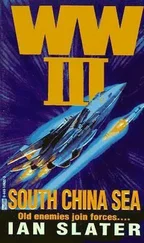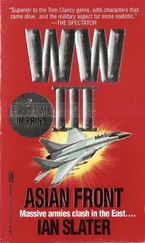There was harried activity aboard the Turner ’s core battle group, which, under the overall command of Admiral J. Bressard, was made up of the Nimitz-class carrier itself, two guided missile Aegis cruisers, a four-ship destroyer squadron, the replenishment vessel Salt Lake City , plus two nuclear attack submarines — one of them Captain Rorke’s USS Utah . The battle group was ordered to maintain station, ready for immediate turnaround. Ten ships in all, nine of them already leaving Washington State’s naval base at Everett and the Bremerton yard, the group’s replenisher to follow as soon as she was “choc-a-bloc” with supplies, in the words of her highly efficient, no-nonsense captain, Diane Lawson. Fuel for the huge, 98,000-ton Turner was no problem, its two Westinghouse nuclear reactors having enough power to drive its four shafts for ten to fifteen years, or for a million nautical miles, before the fuel cores needed to be replaced.
Below, in the carrier’s garage-smelling hangar deck — nearly one and a third times bigger than a football field and three stories high — an army of mechanics of the carrier’s 2,800 air wing personnel were feverishly getting ready for the arrival of the air wing from Whidbey Island. This would consist of eighty-five aircraft, including twenty F-14 Tomcats, F-18 Hornets, A-6E Intruders, E2 Hawkeyes, EA-6B Prowlers, S-3 Vikings, and six Seahawk helos, the last of the urgently recalled ship’s personnel on leave having readied the ship only forty minutes before she’d cast off from the Bremerton yard.
The Turner ’s CBG deployment to join McCain was seen by some young Americans on the liberal left as “excessive,” even “bullying,” in nature, but the beginning of the twenty-first century had taught many Americans, and not only those in the country’s armed services, that it was best to contain a danger rather than let it fester unchallenged as happened to the Taliban in Afghanistan. And 9/11, showing terrorists reaching into the heart of America itself, had certainly influenced people as well.
The White House, meanwhile, was receiving “Presidential Eyes Only” traffic from the U.S. Embassy in Beijing, General Chang having advised Bill Heinz that the Gong An Bu believed Li Kuan’s terrorists might have penetrated American seaports, particularly on America’s west coast. Chang said that suspected Xinjiang and Kazakhstani terrorists “under questioning” by the Gong An Bu had revealed that small suicide inflatable boats and dirty bombs, possibly hidden in SeaLift containers, had been smuggled into American and possibly Canadian waters.
Aboard the USS Turner , in what at the time seemed an unrelated and banal incident, Admiral Bressard was told that the fan room located on the third deck, port side, was experiencing some difficulty, which meant air circulation wasn’t up to par. The world being divided into those who are always too hot and those who are too cold, the “hot” mechanics were complaining so much it was suggested that the two enormous steel doors dividing the hanger into three distinct areas be opened. The officer of the deck refused. The idea of having the two huge doors closed in these hectic hours of getting underway was that if a fire or explosion occurred in one or more of the planes or from the ordnance — of which there was three thousand tons, in addition to the ship’s 2.68 million gallons of aviation fuel — the doors would seal off the hangar into three distinct zones, each as survivable as the other two thousand watertight compartments throughout the twenty-three transverse and longitudinal bulkheads.
Admiral Bressard looked ahead into the darkness of the Juan de Fuca Strait and at the two protective Aegis cruisers. The one off to his right was all but invisible against the rugged mass that was the southern coast of Vancouver Island. The silhouette of the other Aegis, on the Turner ’s left flank, was lost against the coast of Washington’s Olympic peninsula. Then came the 4,315-ton Arleigh Burke — class destroyer squadron, two abaft and two astern of the carrier, and up ahead one of the two escorting flank attack submarines, the smallest vessels in Turner ’s battle group. But having twelve vertical launch tubes for nuclear warhead Tomahawk cruise missiles, each of the converted Lafayette-class subs packed a powerful punch. The other sub, maintaining station farther west, moving slowly at sixty feet below to join the battle group, was Rorke’s 7,800-ton Utah , none of its crew happy at having been so near yet so far from home.
Alicia Mayne was the unhappiest of all, keen to get off the boat onto terra firma and back to her lab. She liked Rorke and the super politeness of the Utah ’s crew, a naval tradition whether on sub or carrier, where long, narrow passageways, needed to make room for more equipment and close living quarters, demanded exceptional courtesy. But Alicia yearned for the lavish comforts of a full-size bedroom, the sheer pleasure of a walk outside, the sensuous feel of rain on one’s face. No matter how much modern commentators emphasized the roominess of the 377-foot-long, thirty-four-foot-diameter Virginia sub compared to other subs, it was still a submarine, a cooped-up world in which the normal rhythms of life ashore are lost. Only the “redded out” lighting, making the submariners’ eyes more able to adjust from red to the darkness, should they have to surface, told them it was night in the world above.
Alicia could smell steaks cooking in the galley, and she heard the whir of the big mixer mashing potatoes and the thud from what she guessed was something bumping against the hull, forward and below the sail. Then all hell broke loose.
The explosion shook the Utah like a toy, things crashing everywhere, burned wires smoking, and suddenly the pastel blue of the wardroom walls bulged out in huge blisters from the intense heat. She could hear men yelling and screaming, the sub still shaking so violently that what she took to be dust falling was in fact fine particles of pipe-wrap insulation squeezing through multiple fissures in the pipes’ sheathing. From a broken elbow joint, superheated jets of steam sliced across the passageway in which she could already hear doors and hatches slamming shut, turning the long, cigar-shaped sub into a series of watertight compartments, so that whatever section had been hit might be effectively sealed off from all others.
Alarms continued to sound, the OOD calling for damage reports as Rorke ran from his stateroom to Control and other men rushed to their stations. Rorke could feel the sub desperately trying to assume her emergency up angle in order to surface, but the forward ballast tanks were obviously damaged. In fact, there was a gash approximately three and a half by one foot wide on the starboard bow tank between the chin’s sonar array and the sail. The pumps seemed unable to evict the torrent of water required to give the Utah the positive buoyancy she needed to rise, which she had to do quickly before becoming so heavy she’d be driven to the bottom. Rorke immediately ordered all engines stopped, diving planes at surfacing elevation, and the crew ready to abandon ship.
The starboard-side bulkhead of the battered forward tank was showing spider fissures visible only on the control monitor’s zoom, and in the few seconds it took for the operator to tell the OOD about it, the spidery fissures had gone to a “visible web,” the tiny cracks emitting powerful pencil-lead-thin jets of water. Rorke quickly realized that with the air pressure coils in the ballast tank ruptured, there was no hope of the Utah surviving, unless he could somehow achieve an emergency blow. In its present fragile state, the boat hovered dangerously close to negative buoyancy. If that happened, it would plunge, reaching breakneck speeds, plummeting past its crush depth and smashing into the seabed, its air-filled chambers popping like tin cans under the sledgehammer weight of the ocean.
Читать дальше












